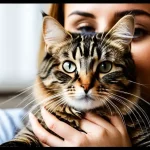Behavioral Adaptations of Cats to UK Urban Environments
Urban cat behavior in UK cities reflects a remarkable ability to adapt to densely populated and noisy surroundings. UK city cats often exhibit shifts in activity patterns, becoming more nocturnal or crepuscular to avoid peak human bustle. This behavior reduces stress and maximizes peaceful exploration times.
Cat adaptation also involves increased use of vertical space. Many urban environments lack extensive outdoor areas, prompting cats to climb furniture, shelves, and window perches. Indoor enrichment through climbing structures and puzzle feeders becomes essential. This not only satisfies their natural urge to climb and hunt but also reduces boredom and destructive tendencies.
Also to read : What Are the Myths Surrounding Cats in the UK?
Social interactions change notably. Urban cat behavior towards humans often grows more dependent but cautious, as cats balance the need for social contact with a preference for safe retreat spaces. Interactions with other cats and domestic pets can be competitive or cooperative, shaped by territory constraints and resource availability. Understanding these nuanced adaptations helps owners provide environments that respect UK city cats’ complex behavioral needs, enhancing welfare in urban settings.
Physical and Ecological Challenges for Urban Cats in the UK
Urban challenges for cats in the UK are significant and multifaceted. One of the primary city dangers is traffic, which poses a constant risk to cats navigating busy streets. Pollution in urban areas also affects their respiratory health, especially in locations with heavy vehicle emissions. Limited access to safe outdoor spaces confines many cats, restricting natural activities and exploration.
Also to discover : What Are the Health Benefits of Having a Cat as a Pet?
Interaction with other urban animals introduces territorial disputes and potential conflicts. Urban cats often encounter birds, rodents, and other neighborhood cats, which can lead to injuries or stress. Furthermore, the dense, fragmented layout of UK cities impacts how cats move. Patchy green spaces serve as critical corridors, yet these are often insufficient in size or connectivity, limiting roaming areas and safe retreats.
Understanding the interplay between city infrastructure and UK urban wildlife is essential to addressing these challenges. For pet owners and local planners alike, recognizing the constraints on feline movement patterns helps inform better support for urban challenges for cats. Providing more accessible green areas and safer pathways can mitigate risks, enhancing cats’ quality of life in the bustling urban environment.
Supporting Cat Welfare in Urban UK Settings
Cats living in urban areas face unique challenges, making urban cat welfare a crucial focus for responsible owners. Creating a safe environment for cats UK involves balancing indoor comfort with opportunities for exploration. Providing stimulating indoor spaces with climbing structures, interactive toys, and cozy hideaways keeps cats mentally and physically engaged despite limited outdoor access.
When outdoor access is possible, it must be secure. Enclosed gardens or wildlife-friendly cat patios, often called “catios,” allow safe exploration while protecting cats from hazards like traffic and predators. This controlled exposure supports natural behaviors reducing stress and boredom.
Regular veterinary care is vital in cities where exposure to infectious diseases can be higher. Routine cat care includes vaccinations, flea and worm prevention, and microchipping, essential for quick identification should a cat stray in busy urban environments. Microchipping is recommended by many UK animal welfare organizations as a reliable safeguard.
Community initiatives, including local cat welfare groups and rehoming charities, offer resources and support to urban cat owners. Engaging with these networks can enhance welfare through shared advice, lost-and-found databases, and community education on responsible ownership. These measures collectively uphold the wellbeing of cats in bustling cityscapes.
UK-Specific Data and Examples on Urban Cats
Exploring how city cats thrive and adapt across the UK
Recent UK cat statistics reveal a growing trend of cats living in urban environments. Approximately 25% of UK households own at least one cat, with higher concentrations in cities such as London and Manchester. Urban areas report a population density of cats that challenges typical perceptions, showing strong adaptability in confined spaces.
Case studies highlight fascinating adaptation patterns. In London, cats utilize green rooftops or small garden patches for hunting and resting, showcasing remarkable flexibility. Manchester’s urban cats often navigate complex street environments, learning to avoid traffic and human hazards. These examples illustrate how cats adjust behaviourally and physically to city life.
Veterinary sources and animal welfare organisations in the UK emphasise the importance of understanding these adaptations for better care. Urban cats face unique health risks often linked to pollution or restricted outdoor access. Organisations suggest tailored healthcare plans, considering urban stress factors and the limited hunting opportunities for indoor cats.
Such UK-specific insights not only assist owners in managing urban pets but also guide policies supporting feline welfare in metropolitan zones. This information underlines cats’ resilience within urban settings and encourages responsible pet ownership.


